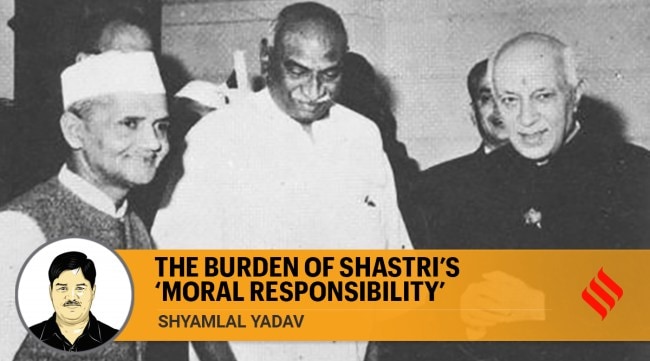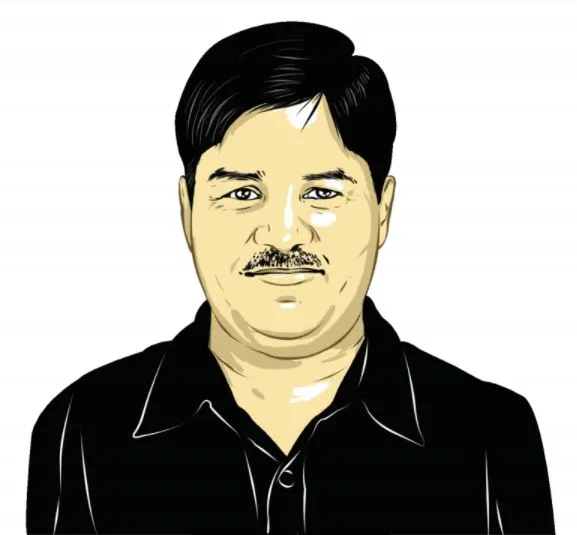Opinion After every railway tragedy, the burden of Shastri’s ‘moral responsibility
Each time there is a demand for the resignation of the Railway Minister on grounds of “moral responsibility” after an accident, the example of former Prime Minister Lal Bahadur Shastri is always quoted.
 Shastri with Congress stalwarts Pandit Nehru and K Kamaraj. File
Shastri with Congress stalwarts Pandit Nehru and K Kamaraj. File
The trains are back on track in Balasore, Odisha, where an accident involving two passenger trains and one goods train claimed 288 lives and left hundreds injured. As rescue work started immediately after the accident, so did the demand by the Opposition for the resignation of Railway Minister Ashwini Vaishnaw.
Each time there is a demand for the resignation of the Railway Minister on grounds of “moral responsibility” after an accident, the example of former Prime Minister Lal Bahadur Shastri is always quoted. Shastri stepped down after the second of two major accidents that happened in a space of three months — between September and November — in 1956.
Shastri was sworn in as Minister of Railways and Transport on May 13, 1952, in Pandit Jawaharlal Nehru’s first Cabinet. A May 1956 report on his ministry by the Estimates Committee of the Lok Sabha had more or less lauded the government’s efforts on issues related to accidents.
But the good run did not last long. Early on September 2, 1956, the Secunderabad-Dronachalam passenger train met with an accident between Jadcherla and Mahabubnagar, both in today’s Telangana.
Shastri visited the accident site. On September 5, 1956, he tabled a report in the Lok Sabha containing instructions issued to Railways on inspection of bridges. On September 13, 1956, Shastri said in the House, “Needless to say, this accident has grieved me most and I feel sadder after having seen the things on site. The memory of the unfortunate persons who were killed will haunt me, perhaps, for a long time to come. The death toll, I am now advised, has reached the figure of 117.”
The government — Shastri in particular — was criticised in the House by the Opposition over the accident and the handling of the situation. K Ananda Nambiar, an MP from the Communist Party of India, said, “The (Railway) Board and the Ministry are responsible for it (the accident). They must explain, they must quit.”
Shastri offered his resignation to Prime Minister Nehru, but he did not accept it. Shastri continued as Railway Minister. Things were back on track but not for long.
Barely three months later, another tragedy struck. Early on November 23, 1956, the Tuticorin Express plunged into the Marudaiyar River. Over 150 died and more than 100 were injured.
K Muthuswamy Vallatharasu, MP from Pudukottai, from Acharya J B Kriplani’s Kisan Mazdoor Praja Party (KMPP), moved an adjournment motion on the accident in the Lok Sabha. Challenging the official toll, he said, “In yesterday’s paper, The Indian Express, I saw a report that there were still about 200 or more (people) lying buried below, and they have yet to be lifted. I seek some clarification about this. Whether the number is 200 or 300 or more, is not the question now.”
As the Opposition stepped up its attack, on November 26, 1956, Pandit Nehru announced Shastri’s resignation. Speaking in the Lok Sabha, the PM said, “I do feel that in a matter of this kind, no excuse is good enough. And the thing that has moved all of us, I am sure, is that the same type of disaster should occur, broadly speaking in the same area or nearby twice within a short period, and three times in the course of a year or two. A greater warning no one can have and, as I said, every possible step should be taken to run our Railways so as to produce a sense of confidence and security.”
The PM then proceeded to read Shastri’s resignation letter in the House, “The number of casualties is already much higher than in the former, and I do not know what figure it will touch, as it has not been possible to remove all the debris so far. And then there are many who are grievously injured. I can very well realise the concern of the people and of Parliament about this very sad and shocking disaster. You were generous enough not to accept my resignation when I tendered it last time and I do not wish to embarrass you again. But I do feel that it would be good for me and for the government as a whole if I quietly quit the office I hold. It would, to a great extent, ease the peoples’ minds.”
Nehru told the House, “On receipt of this letter, I talked to him also last night and I saw the great distress in his mind and the burden that he was carrying. Afterwards, I thought of it again and I came to the conclusion that it would be better for me to accept his resignation.”
Shastri’s resignation was accepted with effect from December 7, 1956, and he was replaced by Jagjivan Ram. With that, Shastri ceased to be part of the Nehru Cabinet during the first Lok Sabha. Until his demise in 1966, this marked the only period when Shastri was out of the Union Cabinet.
Following demands raised after these two train accidents, Nehru decided to split the Ministry of Railway and Transport into two — Railways and Transport — when his new Cabinet was formed in the second Lok Sabha, on April 17, 1957. The Ministry of Transport and Communication was given to Shastri. He never returned as Railway Minister again.
The “moral responsibility” of the accident that he owned up to may not have been Shastri’s alone, but it was the first case of its kind in independent India. And his resignation returns to haunt each and every Railway Minister. Every time a big train tragedy happens, Shastri’s “moral responsibility” is quoted by the Opposition, not by the ruling party.






